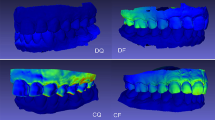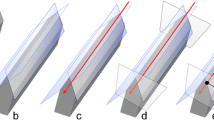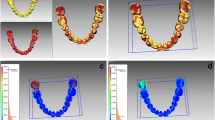Abstract
Objective
The aim of the present cross-sectional study was to compare the interocclusal contact records obtained by three different digital methods (intra- and extraoral digital scanners and T-Scan III system) with the conventional method (articulating paper).
Materials and methods
Twenty-five healthy volunteers were selected. As a control group, maximum intercuspation occlusal contacts were registered and photographed from the patients with an 8 µm articulating paper. Then, intraoral conventional elastomer impressions were taken and after obtaining the corresponding plaster models of every patient they were scanned with an extraoral scanner (Zfx Evolution, Zimmer Biomet Dental) (group 1). Moreover, digital impressions were made with an intraoral scanner (Trios Color POD, Phibo, 3Shape) and contacts were also registered (group 2). Finally, T-Scan III records were made and stored for further analysis (group 3). Two previously calibrated examiners independently evaluated the interocclusal contacts from every group. Data was analyzed by using Kappa index test and Pearson’s chi-square test. Diagnostic tests and ROC curve were also performed.
Results
Kappa interoperator index was 70.6% (better agreement). In Kappa intraoperator index, the best value was obtained in the intraoral scanner group (moderate agreement) and the worst with T-Scan III group (low agreement). ROC curve showed highest values in the intraoral scanner group (0.817) and lowest values in the T-Scan III group (0.613).
Conclusion
Results suggest greater reliability to record occlusal contacts with the intraoral scanner.
Clinical relevance
Intraoral scanners seem to be reliable in registering intermaxillary occlusal contacts when compared with the current gold standard.


Similar content being viewed by others
Change history
19 May 2022
A Correction to this paper has been published: https://doi.org/10.1007/s00784-022-04551-5
References
Nadjmi N, Mollemans W, Daelemans A, Van Hemelen G, Schutyser F, Bergé S (2010) Virtual occlusion in planning orthognathic surgical procedures. Int J Oral Maxillofac Surg 39(5):457–462
Arslan Y, Bankoğlu Güngör M, KarakocaNemli S, Kökdoğan Boyacı B, Aydın C (2017) Comparison of maximum intercuspal contacts of articulated casts and virtual casts requiring posterior fixed partial dentures. J Prosthodont 26(7):594–598
Da Silva Martins MJ, Caramelo FJ, Ramalho da Fonseca JA, Gomes Nicolau PM (2014) In vitro study on the sensibility and reproducibility of the new T-Scan®III HD system. Rev Port Estomatol Med Dent e Cir Maxilofac 55(1):14–22. https://doi.org/10.1016/j.rpemd.2014.01.001
Gjelvold B, Chrcanovic BR, Korduner EK, Collin-Bagewitz I, Kisch J (2016) Intraoral digital impression technique compared to conventional impression technique. A randomized clinical trial J Prosthodont 25(4):282–287
Delong R, Ko C-C, Anderson GC, Hodges JS, Douglas WH (2002) Comparing maximum intercuspal contacts of virtual dental patients and mounted dental cats. J Prosthet Dent 88(6):622–630. https://doi.org/10.1067/mpr.2002.129379
Solaberrieta E, Otegi JR, Goicoechea N, Brizuela A, Pradies G (2015) Comparison of a conventional and virtual occlusal record. J Prosthet Dent 114(1):92–97. https://doi.org/10.1016/j.prosdent.2015.01.009
Alghazzawi TF (2016) Advancements in CAD/CAM technology: options for practica l implementation. J Prosthodont Res 60(2):72–84. https://doi.org/10.1016/j.jpor.2016.01.003
Luo Q, Ding Q, Zhang L, Xie QF (2019) Quantitative analysis of occlusal changes in posterior partial fixed implant supported prostheses. J Peking Univ Health Sci 51(6):1119–1123. https://doi.org/10.19723/j.issn.1671-167X.2019.06.025
Abarza Arellano L, Sandoval Vidal P, Flores Velásquez M (2016) Registro interoclusal digital en rehabilitación oral: «Sistema T-Scan® III». Revisión bibliográfica. Rev Clín Periodon Implantol Rehabil Oral 9(2):95–101
Ruttitivapanich N, Tansalarak R, Palasuk J, Pumklin J (2019) Correlation of bite force interpretation in maximal intercuspal position among patient, clinician, and T-scan III system. Eur J Dent 13(3):330–334
Seo JM, Oh WS, Lee JJ (2019) A technique for verifying the accuracy of the virtual mounting of digital scans against the actual occlusal contacts. J Prosthet Dent 121:729–732. https://doi.org/10.1016/j.prosdent.2018.08.003
Solaberrieta E, Arias A, Brizuela A, Garikano X, Pradies G (2016) Determining the requirements, section quantity, and dimension of the virtual occlusal record. J Prosthet Dent 115:52–56
Fasbinder DJ, Poticny DJ (2010) Accuracy of occlusal contacts for crowns with chairside CAD/CAM techniques. Int J Comput Dent 13:303–316
Ahlholm P, Sipilä K, Vallittu P, Jakonen M, Kotiranta U (2018) Digital versus conventional impressions in fixed prosthodontics: a review. J Prosthodont 27:35–41
Carey JP, Craig M, Kerstein RB, Radke J (2007) Determining a relationship between applied occlusal load and articulating paper mark area. Open Dent J 1:1–7
Saad MN, Weiner G, Ehrenberg D, Weiner S (2008) Effects of load and indicator type upon occlusal contact markings. J Biomed Mater Res B Appl Biomater 85:18–22
Qadeer S, Kerstein R, Kim RJ, Huh JB, Shin SW (2012) Relationship between articulation paper mark size and percentage of force measured with computerized occlusal analysis. J Adv Prosthodont 4:7–12
Saracoglu A, Ozpinar B (2002) In vivo and in vitro evaluation of occlusal indicator sensitivity. J Prosthet Dent 88(5):522–526
Straga RW (2009) Comparison of occlusal contacts on mounted dental models to contacts identified on digital 3D models using a new virtual alignment method. University of British Columbia, Vancouver, p 10–67
DeLong R, Knorr S, Anderson GC, Hodges J, Pintado MR (2007) Accuracy of contacts calculated from 3D images of occlusal surfaces. J Dent 35(6):528–534
Gintaute A, Keeling AJ, Osnes CA, Zitzmann NU, Ferrari M, Joda T (2020) Precision of maxillo-mandibular registration with intraoral scanners in vitro. J Prosthodont Res 64(2):114–119. https://doi.org/10.1016/j.jpor.2019.05.006
Abdulateef S, Edher F, Hannam AG, Tobias D, Wyatt CCL (2020) Clinical accuracy and reproducibility of virtual interocclusal records. J Prosthet Dent 124(6):667–673
Gümüş HÖ, Kılınç Hİ, Tuna SH, Ozcan N (2013) Computerized analysis of occlusal contacts in bruxism patients treated with occlusal splint therapy. J Adv Prosthodont 5(3):256–261. https://doi.org/10.4047/jap.2013.5.3.256
Solaberrieta E, Etxaniz O, Otegi JR, Brizuela A, Pradies G (2017) Customized procedure to display T-Scan occlusal contacts. J Prosthet Dent 117(1):18–21. https://doi.org/10.1016/j.prosdent.2016.07.006
Wong KY, Rcsed M, Esguerra RJ, Chia VAP, HanTan Y, Choon Tan KB (2018) Three-dimensional accuracy of digital static interocclusal registration by three intraoral scanner systems. J Prosthodont 27:120–128
Funding
This project was not supported by the industry. All funds came from Complutense University of Madrid.
Author information
Authors and Affiliations
Corresponding author
Ethics declarations
Ethical approval
All procedures performed in the present study were in accordance with the ethical standards of the institutional research committee and with the 1964 Helsinki declaration and its later amendments or comparable ethical standards. The present study has the approval of the ethical committee of the “Hospital Clínico San Carlos” with the number C.P. – C.I. 16/273-E.
Conflict of interest
The authors declare no competing interests.
Informed consent
Informed consent was obtained from all individual participants included in the present study. They were informed verbally and in writing of the advantages and disadvantages of participating in the study.
Additional information
Publisher’s note
Springer Nature remains neutral with regard to jurisdictional claims in published maps and institutional affiliations.
The original version of this article was revised: n the discussion on page 1961 in the following sentence „This can be explained because of the thickness of the articulating paper (8 μm) used as a gold standard is significantly lower than that of the T-Scan sensors (250 μm) and this can influence on the results, generating false positives, as well as errors when obtaining the registration [23].“ (250 µm) has to be replaced by (100 µm).
Rights and permissions
About this article
Cite this article
Fraile, C., Ferreiroa, A., Romeo, M. et al. Clinical study comparing the accuracy of interocclusal records, digitally obtained by three different devices. Clin Oral Invest 26, 1957–1962 (2022). https://doi.org/10.1007/s00784-021-04174-2
Received:
Accepted:
Published:
Issue Date:
DOI: https://doi.org/10.1007/s00784-021-04174-2




